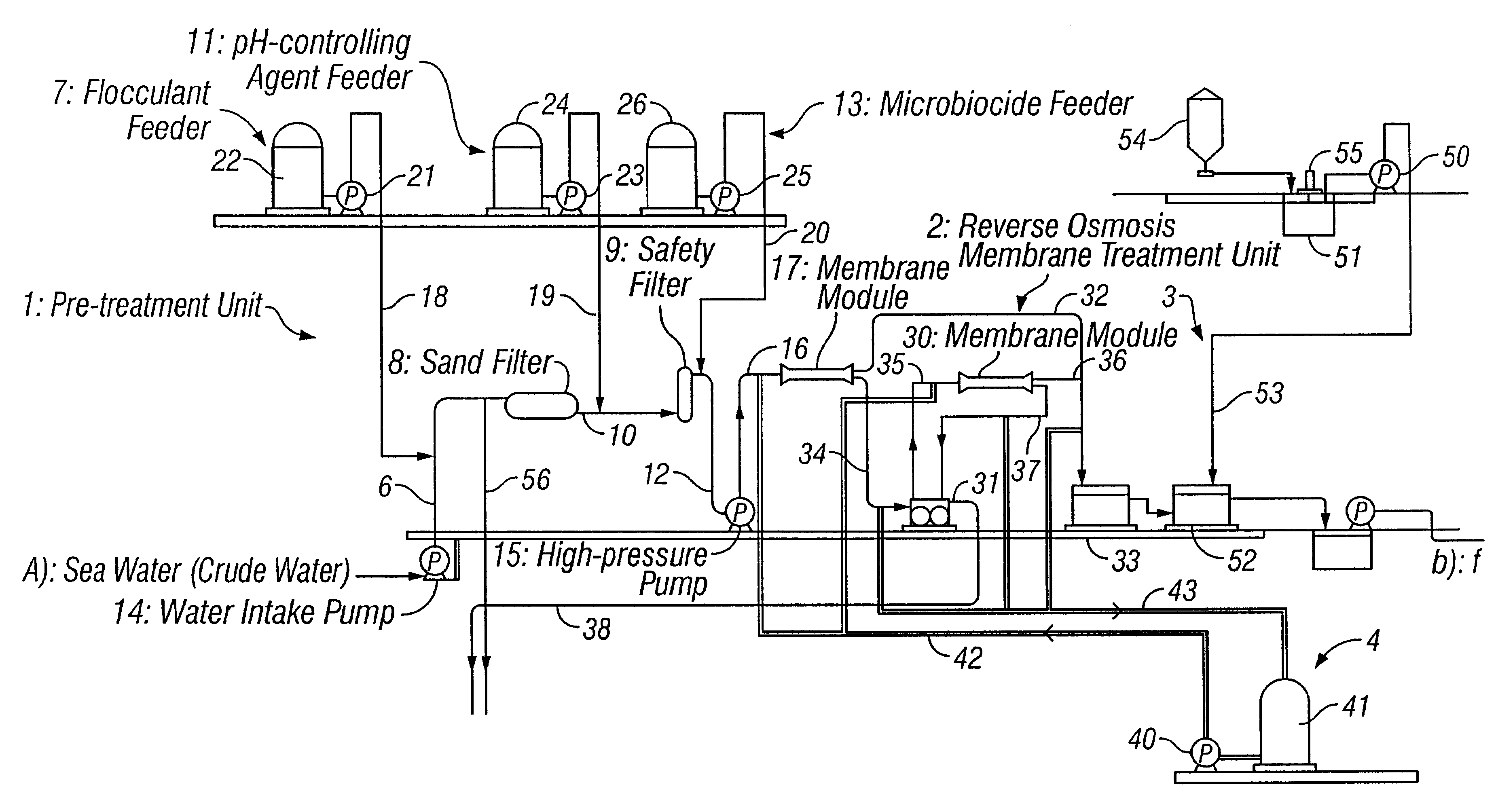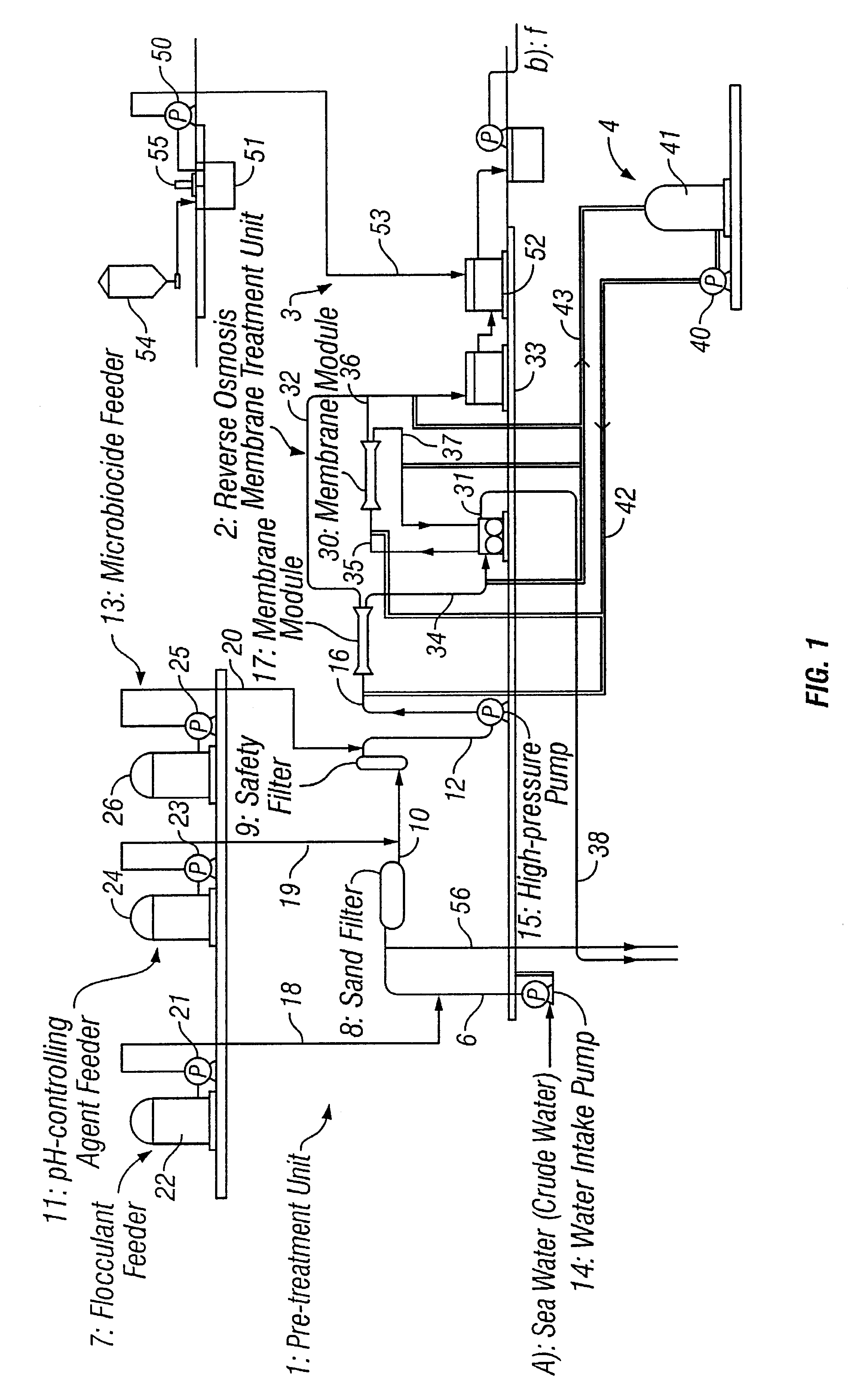Method for inhibiting growth of bacteria or sterilizing around separating membrane
a technology of separating membrane and growth inhibition, which is applied in the direction of membranes, separation processes, water/sewage treatment by oxidation, etc. it can solve the problems of not being able to reduce the ph value of the water system to such a degree that ordinary bacteria existing therein could be killed, and the quality of the water is not good. , to achieve the effect of reducing the ph of the solution, reducing the proportion of acid-resistant bacteria in seawater, and improving the quality of water quality
- Summary
- Abstract
- Description
- Claims
- Application Information
AI Technical Summary
Benefits of technology
Problems solved by technology
Method used
Image
Examples
reference example 1
A predetermined amount of a suspension of living cells of Escherichia coli K12 IFO 3301 was added to a physiological saline solution (having a salt concentration of 0.9%) that had been subjected to pressure disinfection (at 120.degree. C. for 15 minutes) and then to pH control with sulfuric acid added thereto, and kept at 20.degree. C. for a predetermined period of time, and the survival rate of the cells was obtained by dividing the number of the living cells still remaining in the solution by the number of the cells added to the solution. As a result, the survival rate of the cells was not lower than 90% when the solution to which had been added 10 ppm of sulfuric acid and which had a pH of 4.7 was kept under the condition for 2.5 hours. However, the survival rate of the cells in the solution having a pH of 3.2, to which had been added 50 ppm of sulfuric acid, was 90% after kept for 0.5 hours, 20% after kept for 1 hour, and 1% or lower after kept for 2.5 hours. When 100 ppm of sul...
reference example 2
To a commercially-available, 3.5% artificial seawater that had been subjected to pressure disinfection (at 120.degree. C. for 15 minutes) and then to pH control with sulfuric acid added thereto, added was a predetermined amount of the same suspension of Escherichia coli cells as in Example 1, or a predetermined amount of a suspension of a solid deposit on a reverse osmosis membrane having been used in seawater desalination, or a predetermined amount of un-identified bacteria as separated from the solid deposit suspension, of which the number was the largest among all bacteria separated from the suspension. Then, each seawater was kept as such at 20.degree. C. for a predetermined period of time, and the survival rate of the cells therein was measured. The data are shown in Table 1. For comparison, 500 ppm of sodium bisulfite was added in place of sulfuric acid, and the data obtained are also shown in Table 1. From the data in Table 1, it is understood that the cells in the seawater w...
example 1
Two membrane separation units each having a reverse osmosis membrane of polyamide were driven for seawater desalination through reverse osmosis filtration to produce fresh water. To one of the two units, crude seawater having been pre-treated and subjected to pH control to have a pH of from 3.5 to 4.0 with sulfuric acid added thereto was applied everyday for a period of 30 minutes, a day. In that condition, the two units were continuously driven for 1 month. As a result, the pressure loss in the unit to which no sulfuric acid had been added increased, but the pressure loss in the other unit to which sulfuric acid had been added did not change. While the units were driven under the condition, the number of the living cells in the concentrate having passed through each unit was counted. As a result, the number of the living cells in the concentrate in the unit that had been subjected to the sulfuric acid treatment was lowered to 1 / 100 or less, as compared with that of the living cells...
PUM
| Property | Measurement | Unit |
|---|---|---|
| pH | aaaaa | aaaaa |
| pH | aaaaa | aaaaa |
| pH | aaaaa | aaaaa |
Abstract
Description
Claims
Application Information
 Login to View More
Login to View More - R&D
- Intellectual Property
- Life Sciences
- Materials
- Tech Scout
- Unparalleled Data Quality
- Higher Quality Content
- 60% Fewer Hallucinations
Browse by: Latest US Patents, China's latest patents, Technical Efficacy Thesaurus, Application Domain, Technology Topic, Popular Technical Reports.
© 2025 PatSnap. All rights reserved.Legal|Privacy policy|Modern Slavery Act Transparency Statement|Sitemap|About US| Contact US: help@patsnap.com


